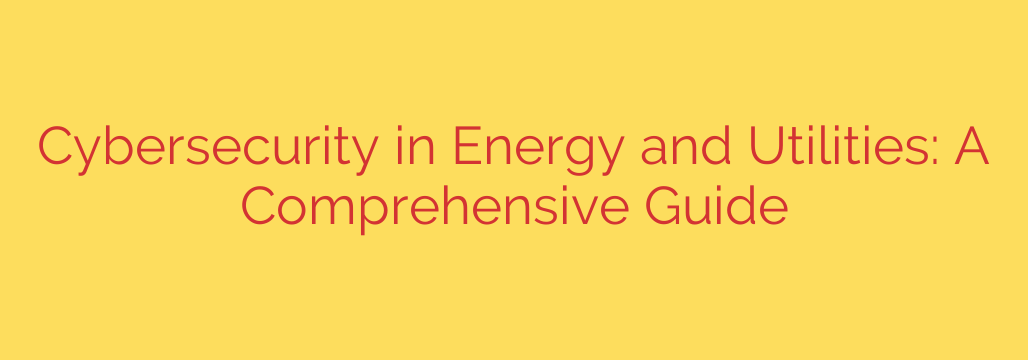
The Digital Frontline: Protecting Energy and Utilities from Cyber Threats
The energy and utilities sector is the backbone of modern society. From the electricity that powers our homes and hospitals to the water we drink and the natural gas that heats our buildings, these services are fundamental to our daily lives and national security. But as this critical infrastructure becomes more connected and digitized, it also becomes a prime target for sophisticated cyberattacks.
Protecting this sector isn’t just about preventing data breaches; it’s about safeguarding the physical world from digital threats. A successful attack could trigger widespread power outages, disrupt water supplies, and cause catastrophic economic and social turmoil. Understanding the unique vulnerabilities and adopting a proactive security posture is no longer optional—it’s an absolute necessity.
The Unique Challenge: When IT and OT Collide
Unlike many other industries, the energy sector operates on two distinct technological planes: Information Technology (IT) and Operational Technology (OT).
- IT systems are what most people think of as “tech”—corporate networks, email servers, billing systems, and customer databases.
- OT systems are the industrial control systems (ICS) that manage physical processes. This includes Supervisory Control and Data Acquisition (SCADA) systems that monitor pipelines, programmable logic controllers that operate electrical substations, and other machinery that keeps the power flowing.
Historically, OT networks were isolated, or “air-gapped,” from the outside world. They were self-contained systems designed for reliability and safety, not for internet connectivity. The problem is that the modern drive for efficiency has led to the convergence of IT and OT networks. While this connectivity allows for remote monitoring, predictive maintenance, and data-driven insights, it has also punched holes in the very defenses that once protected our most critical systems.
Many of these OT environments rely on legacy systems that are decades old. These systems were never designed with cybersecurity in mind and are often difficult, if not impossible, to patch or update without causing operational downtime. This creates a perfect storm where aging, vulnerable infrastructure is newly exposed to a world of advanced digital threats.
Top Cyber Threats Facing the Energy Sector
The threats targeting energy and utility companies are diverse and dangerous. Attackers range from nation-state actors seeking to destabilize rivals to cybercriminals motivated by financial gain. Key threats include:
- Ransomware: Attacks that encrypt critical systems and demand a payment to restore access. In the utilities sector, this can halt operations, disrupt billing, and even shut down physical processes.
- Nation-State Attacks: Hostile governments may attempt to infiltrate energy grids to conduct espionage or, in a worst-case scenario, disable infrastructure as an act of war.
- Supply Chain Attacks: Compromising a trusted third-party vendor—like a software provider or equipment manufacturer—to gain backdoor access into the utility’s network.
- Insider Threats: Whether malicious or unintentional, an employee with access to sensitive systems can cause significant damage by disabling safety controls, stealing data, or inadvertently introducing malware.
Building a Resilient Defense: Actionable Security Strategies
Protecting critical infrastructure requires a multi-layered, defense-in-depth strategy. Complacency is not an option. Companies must move beyond basic compliance and build a truly resilient security culture. Here are essential steps to take:
1. Embrace a Zero-Trust Architecture
The old model of “trust but verify” is dead. A zero-trust model assumes that no user or device is inherently trustworthy, whether it’s inside or outside the network. Every request for access must be continuously authenticated, authorized, and encrypted. This approach significantly limits an attacker’s ability to move laterally through a network even if they breach the perimeter.
2. Enforce Strict Network Segmentation
Properly segmenting networks is crucial. IT and OT networks should be kept as separate as possible, with tightly controlled firewalls and access points between them. If the corporate IT network is compromised by ransomware, strong segmentation can prevent the attack from spreading to the sensitive OT environment that controls physical operations.
3. Implement Continuous Monitoring and Threat Detection
You cannot defend against what you cannot see. Organizations need 24/7 visibility into both their IT and OT networks. This requires specialized tools that can understand industrial protocols and identify anomalous behavior indicative of a cyberattack. Early detection is key to mitigating damage before it becomes catastrophic.
4. Develop and Rehearse an Incident Response Plan
It’s not a matter of if an attack will occur, but when. Having a well-documented incident response (IR) plan is non-negotiable. This plan should detail the specific steps for detection, containment, eradication, and recovery. Crucially, the IR plan must be regularly tested through tabletop exercises and simulations to ensure every team member knows their role in a crisis.
5. Prioritize Security Awareness and Training
The human element is often the weakest link. Regular, role-specific security training is essential to arm employees with the knowledge to recognize phishing attempts, practice good cyber hygiene, and understand the unique risks associated with their roles, especially for those working with OT systems.
The security of our energy and utilities is a shared responsibility. As the digital and physical worlds become inextricably linked, a proactive, vigilant, and resilient approach to cybersecurity is the only way to ensure the lights stay on for everyone.
Source: https://heimdalsecurity.com/blog/complete-protection-guide-for-cybersecurity-in-energy-and-utilities/








